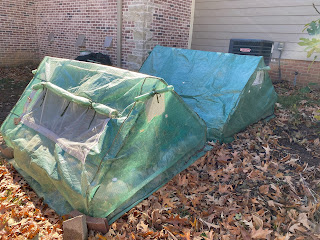 |
| Pop up, walk in greenhouse |
Sunday, November 26, 2023
I like to garden as close to year round as I can. Going to the garden daily gives me something to look forward to and the most nutritious produce you can eat. As soon as a vegetable or fruit is picked, it starts losing its nutritional value. Eating right after picking, maximizes taste and benefits. Besides succession planting and picking varieties best suited for the season you are trying to grow them, a pop-up or portable greenhouse is a cost efficient and fairly easy way to extend the season into winter and then get a jump start in the spring.
I just bought my third portable greenhouse. I bought my first one in 2010 for around $40. It was a smaller pop-up greenhouse that I was able to put 2 nice sized self-watering pots in and keep us in salads all winter. The zipper finally gave out about 6 years ago. I bought a larger portable greenhouse that is 6' wide x 5' deep by 3' tall to replace it in 2018 for around $45. A couple of years ago, I bought a second one just like it. The plastic material is started to degrade on the 2018 greenhouse and I can't get the same model any longer. Last year, I just put a material row cover over the top of it during the coldest weeks and that worked fine so that is my plan for this year, too.
In the fall, winter and spring, I grow greens in these smaller portable greenhouses in self-watering pots. As long as the greenhouse is closed up, you don't have to worry about watering as the moisture that evaporates, condenses on the inside of the plastic and drips back down on the plants. I typically only water a couple of times after putting the covers on and closing them up. If it is a warmer day and calling for rain, I pull off the covers to let them get a good soaking.
I also plant Austrian peas in with the greens. You can plant those now and they will survive even uncovered all winter. Under cover, they will give tasty pea greens through spring. In early spring, you will get peas as a bonus.
You can grow any cool season crops in a portable greenhouse. I grow chard, celery, parsley, arugula, plantain, lettuce, peas, sprouting broccoli, cultivated dandelions and mustard greens. You could also grow kale, spinach, radishes, turnips, kohlrabi, cabbage, broccoli, cauliflower, collards, or carrots. I grow Egyptian walking onions in a pot that I leave uncovered. You could grow onions in a greenhouse. You should grow what you will eat the most often. I like greens because you get a lot for the space and you can harvest the outside leaves and the plants will continue growing new leaves.
Plant growth slows to a crawl towards the end of November until the end of January because daylight is less than 10 hours and it is really cold. The optimum plan is to have your cold season crops to full size before the end of November so you can harvest from them until spring. Keeping your greens in a greenhouse does keep them warmer so you will get more growth on the plants than if they were in the garden bed. Come February, growth really starts popping.
This fall, I ordered a pop up, walk in greenhouse for $148. It is 8' wide x 6' deep and easy to walk in to. I have put all my potted peppers and eggplant along with my tropicals. I am seeing how far I can extend the harvest of the peppers and eggplants. So far, I am still getting fruits off both. I will move my tropicals into the basement and keep them under grow lights when it starts getting below 20F. My tropicals don't do nearly as well inside as outside so I am trying to minimize their indoor stay.
After I take the tropicals out, I have native ferns, native flowers, and herbs I separated last month and transplanted into 4" plastic pots that I will move into the greenhouse in their spot. I hope to improve their survival rate and give them a jump start come spring.
Speaking of spring, I will add metal shelving units to the walk in greenhouse so I can start peppers, tomatoes, eggplant, squash and okra in it. I will try starting the seeds indoors and moving into the greenhouse as well as just starting the seeds in the greenhouse to see which method works the best..
Long term, I'd like to do a larger greenhouse that you run pipes under the ground and back into the greenhouse so it keeps the greenhouse warm without having to put a heater in it. I may be able to keep my tropicals, tomatoes, peppers and eggplants growing all winter with that set up.












